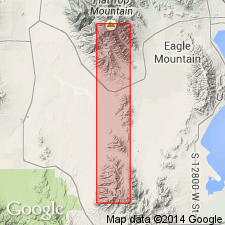
- Usage in publication:
-
- Cedar Fort member
- Modifications:
-
- Named
- Dominant lithology:
-
- Quartzite
- Limestone
- AAPG geologic province:
-
- Great Basin province
- Wasatch uplift
Summary:
Named as a member -the middle member of 5 members -of the Oquirrh formation. Its type locality is on the east limb of the Pole Canyon syncline in sec. 36, T 5 S, R 3 W in Utah Co., UT on the Wasatch uplift. Source of geographic name not stated. Conformably overlies the newly named Meadow Canyon member of the Oquirrh; basal contact placed between less resistant beds of the upper Meadow Canyon and heavy bedded prominent ledge-forming beds of lower Cedar Fort. Conformably underlies the new named Lewiston Peak member of the Oquirrh; basal Lewiston Peak is a dark black-brown to dark sooty gray limestone. Section measured at the type is 1,371 ft thick. Consists dominantly of flesh-colored, fine grained, calcareous to noncalcareous, thin bedded to massive, locally cross-bedded orthoquartzite interbedded with cherty, argillaceous gray limestone, some crystalline limestone and some bioclastic limestone. Characterized by ledge and coxcomb ridges. Age of Desmoinesian determined by presence of fusulinids. Mapped (geologic map) in Utah Co. and adjacent Tooele Co. (Great Basin province).
Source: GNU records (USGS DDS-6; Denver GNULEX).
For more information, please contact Nancy Stamm, Geologic Names Committee Secretary.
Asterisk (*) indicates published by U.S. Geological Survey authors.
"No current usage" (†) implies that a name has been abandoned or has fallen into disuse. Former usage and, if known, replacement name given in parentheses ( ).
Slash (/) indicates name conflicts with nomenclatural guidelines (CSN, 1933; ACSN, 1961, 1970; NACSN, 1983, 2005, 2021). May be explained within brackets ([ ]).

